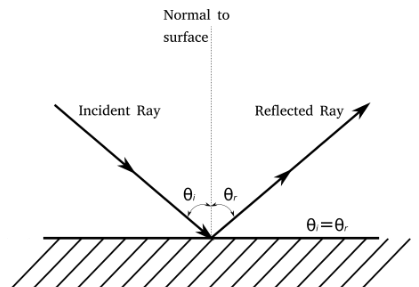
What causes reflection?
Answer
482.1k+ views
Hint:Reflection is the change in direction of a wavefront at an interface between two different media so that the wavefront returns into the medium from which it originated. Examples of reflection are light, sound and water.
Complete answer:
Reflection of light occurs when the waves encounter a surface of the radiation and bounces the waves away from the surface. It happens because the tendency of light is always to travel on a straight path but as light cannot travel through the opaque surface so when it falls on them it disperses to the same medium. The incoming light wave is referred to as an incident wave, and the wave that is bounced back away from the surface is termed a reflected wave.
Reflection can also occur whenever light travels from a medium of a given refractive index into a medium with a different refractive index.

In the diagram, a light ray known as incidence ray strikes a lateral mirror in the center and the reflected ray is reflected, we can measure the angle of incidence \[({\theta _i})\] and the angle of reflection\[({\theta _r})\]. The law of reflection states that \[{\theta _i} = {\theta _r}\], or in other words, the angle of incidence equals the angle of reflection.
Note:The angle which the incident ray makes with the normal is equal to the angle which the reflected ray makes to the same normal. The reflected ray and the incident ray are on the opposite sides of the normal. These are known as the laws of reflection \[{\theta _i} = {\theta _r}\].
Complete answer:
Reflection of light occurs when the waves encounter a surface of the radiation and bounces the waves away from the surface. It happens because the tendency of light is always to travel on a straight path but as light cannot travel through the opaque surface so when it falls on them it disperses to the same medium. The incoming light wave is referred to as an incident wave, and the wave that is bounced back away from the surface is termed a reflected wave.
Reflection can also occur whenever light travels from a medium of a given refractive index into a medium with a different refractive index.

In the diagram, a light ray known as incidence ray strikes a lateral mirror in the center and the reflected ray is reflected, we can measure the angle of incidence \[({\theta _i})\] and the angle of reflection\[({\theta _r})\]. The law of reflection states that \[{\theta _i} = {\theta _r}\], or in other words, the angle of incidence equals the angle of reflection.
Note:The angle which the incident ray makes with the normal is equal to the angle which the reflected ray makes to the same normal. The reflected ray and the incident ray are on the opposite sides of the normal. These are known as the laws of reflection \[{\theta _i} = {\theta _r}\].
Recently Updated Pages
Master Class 12 Economics: Engaging Questions & Answers for Success

Master Class 12 Maths: Engaging Questions & Answers for Success

Master Class 12 Biology: Engaging Questions & Answers for Success

Master Class 12 Physics: Engaging Questions & Answers for Success

Master Class 8 Maths: Engaging Questions & Answers for Success

Class 8 Question and Answer - Your Ultimate Solutions Guide

Trending doubts
Why is there a time difference of about 5 hours between class 10 social science CBSE

Write a letter to the principal requesting him to grant class 10 english CBSE

What is the median of the first 10 natural numbers class 10 maths CBSE

The Equation xxx + 2 is Satisfied when x is Equal to Class 10 Maths

Which of the following does not have a fundamental class 10 physics CBSE

State and prove converse of BPT Basic Proportionality class 10 maths CBSE




